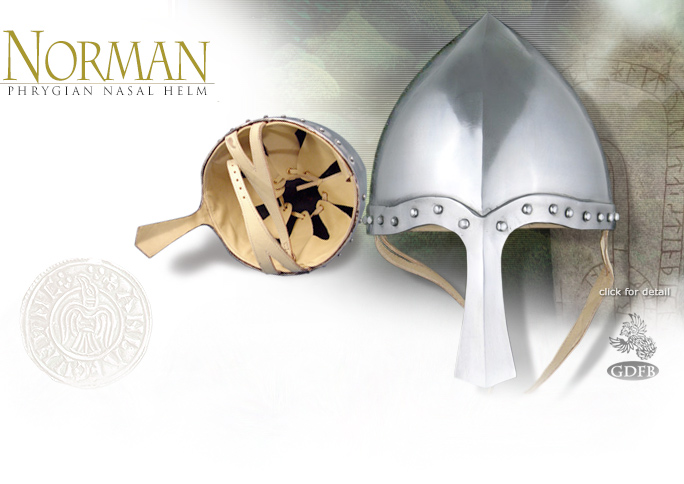NORMAN PHRYGIAN NASAL HELM AB0459/AB0460 by GDFB AB0459/AB0460 by GDFB
The name "Normans" derives from Nortmanni (Northmen), after the Vikings who founded Normandy. The Phrygian style of nasal helm evolved around the Mediterranean and was commonly used by Normans from Sicily during the 12th century. For most of the century nasal helmets with a forward deflected apex, often called the 'Phrygian cap' shape, were in widespread use. This conical nasal helm is made from 14 gauge steel making it suitable for SCA and WMA combat. It has an integrated leather suspension with an adjustable leather tie to alter the internal fit of the helmet. Battle ready for the reenactor, this Norman Helm has an adjustable leather chin strap and buckle to keep the helm affixed to the head during the whirl of melee. Made available in two sizes; Medium AB0459 24-1/4 inch Circumference, and Large AB0460 25-1/2 inch Circumference. The fine workmanship on this Norman Phrygian Nasal Helmet and solid construction insures the best possible protection during battle reenactment.

|
|
|
The nasal helmet would usually have been worn over a mail coif, which protected the lower parts of the head, throat and neck. The coif could be a separate item of armour or be formed as an extension of the mailcoat itself. The existence of rivets and holes around the lower edge of these helmets indicate that they were lined in some manner, though no linings as such have survived. Practical considerations suggest that linings must have been adjustable to ensure a secure fit.
The nasals of these helmets were often so large that the wearer was unrecognizable to an observer. The celebrated incident at the Battle of Hastings, illustrated on the Bayeux tapestry, where William the Conqueror had to lift his helmet to show his troops that he was still alive is an indication of the anonymity nasal helmets produced.
|
|